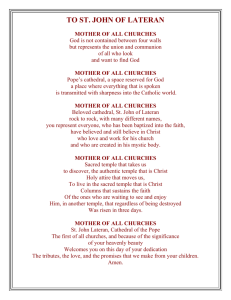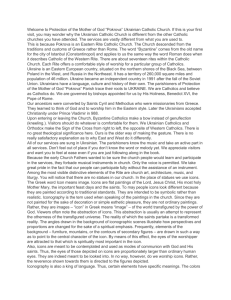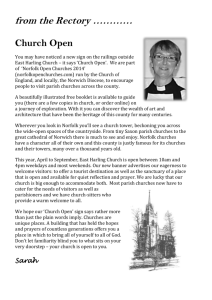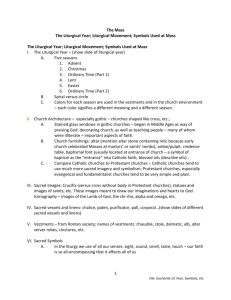The Iconostasis and the Ukrainian Catholic Church in Canada by
advertisement
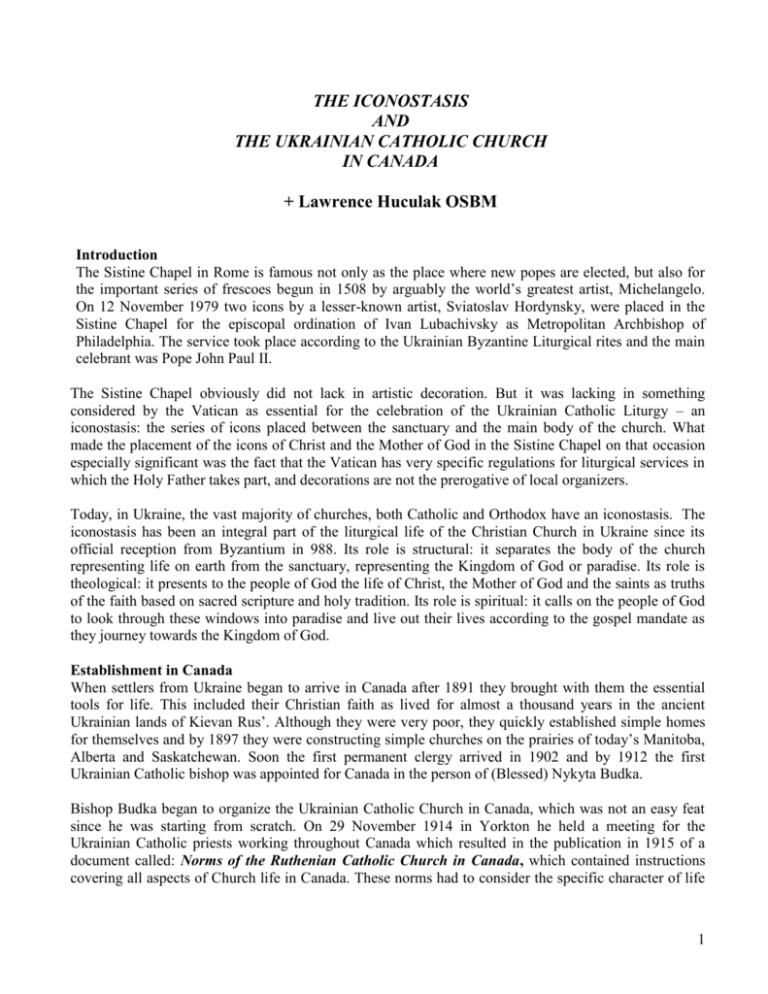
THE ICONOSTASIS AND THE UKRAINIAN CATHOLIC CHURCH IN CANADA + Lawrence Huculak OSBM Introduction The Sistine Chapel in Rome is famous not only as the place where new popes are elected, but also for the important series of frescoes begun in 1508 by arguably the world’s greatest artist, Michelangelo. On 12 November 1979 two icons by a lesser-known artist, Sviatoslav Hordynsky, were placed in the Sistine Chapel for the episcopal ordination of Ivan Lubachivsky as Metropolitan Archbishop of Philadelphia. The service took place according to the Ukrainian Byzantine Liturgical rites and the main celebrant was Pope John Paul II. The Sistine Chapel obviously did not lack in artistic decoration. But it was lacking in something considered by the Vatican as essential for the celebration of the Ukrainian Catholic Liturgy – an iconostasis: the series of icons placed between the sanctuary and the main body of the church. What made the placement of the icons of Christ and the Mother of God in the Sistine Chapel on that occasion especially significant was the fact that the Vatican has very specific regulations for liturgical services in which the Holy Father takes part, and decorations are not the prerogative of local organizers. Today, in Ukraine, the vast majority of churches, both Catholic and Orthodox have an iconostasis. The iconostasis has been an integral part of the liturgical life of the Christian Church in Ukraine since its official reception from Byzantium in 988. Its role is structural: it separates the body of the church representing life on earth from the sanctuary, representing the Kingdom of God or paradise. Its role is theological: it presents to the people of God the life of Christ, the Mother of God and the saints as truths of the faith based on sacred scripture and holy tradition. Its role is spiritual: it calls on the people of God to look through these windows into paradise and live out their lives according to the gospel mandate as they journey towards the Kingdom of God. Establishment in Canada When settlers from Ukraine began to arrive in Canada after 1891 they brought with them the essential tools for life. This included their Christian faith as lived for almost a thousand years in the ancient Ukrainian lands of Kievan Rus’. Although they were very poor, they quickly established simple homes for themselves and by 1897 they were constructing simple churches on the prairies of today’s Manitoba, Alberta and Saskatchewan. Soon the first permanent clergy arrived in 1902 and by 1912 the first Ukrainian Catholic bishop was appointed for Canada in the person of (Blessed) Nykyta Budka. Bishop Budka began to organize the Ukrainian Catholic Church in Canada, which was not an easy feat since he was starting from scratch. On 29 November 1914 in Yorkton he held a meeting for the Ukrainian Catholic priests working throughout Canada which resulted in the publication in 1915 of a document called: Norms of the Ruthenian Catholic Church in Canada, which contained instructions covering all aspects of Church life in Canada. These norms had to consider the specific character of life 1 in Canada including the great distances between communities, the lack of goods and services, and the great poverty of the Ukrainian settlers. In Part 3 General Remarks under the section entitled: Churches and Holy Tables, we read the following: Each community is to endeavor to have an iconostasis in the church, for which, however, they must obtain separate approval of the [Bishop] Ordinary. Where it is not permissible to erect an iconostasis, it is necessary at least to construct the holy and diaconal doors, and stationary icons between them. Above the holy doors is to be placed an icon of the Last Supper, and beyond the diaconal doors (on the walls), on the right, an icon of the patron saint, and on the left, an icon of St. Nicholas; if not, then [erect] side holy tables with these same icons. [1] We see then the continuity of the liturgical life, including the iconostasis that was brought to Canada from Ukraine. In spite of the hardships of pioneer life, the church building and its interior setup was not to be neglected. The Roman Liturgical Books of the 1940’s The Ukrainian Catholic Church requires a variety of books for its liturgical life. There have often been difficulties in maintaining an adequate supply of these texts, plus a need to ensure that they are correct and reflect the needs of the Church. Since the Ukrainian Catholic bishops in the 1930’s were unable for a variety of reasons to agree upon the publication of needed liturgical books, they asked the Holy See in Rome to do this. Beginning in 1944 the Holy See edited and printed a series of liturgical texts for the Ukrainian Catholic Church, under its older name “Ruthenian”. This included a text called: Ordo Celebrationis – The Order for the Celebration of Vespers, Orthros and the Divine Liturgy according to the Ruthenian Recension, which outlined general liturgical norms to be followed. In paragraph 6 we read: The iconostasis has an image of the Savior to the right of the central doors, and an image of the Theotokos to the left; the other icons are arranged according to the various local customs. Parecclesia [side altars] and chapels should have their own iconostases. A Holy Table, which lacks an iconostasis, is not considered truly suitable for divine services. [2] This instruction states very clearly that a sanctuary is not complete until it has an iconostasis. The other liturgical books printed by the Holy See include many references to the iconostasis, indicating its essential role in the liturgical life of the Ukrainian Church. A Metropolitan See for Ukrainian Catholics in Canada From the time of Bishop Budka the Ukrainian Catholic Church in Canada continued to grow. By 1956 it had expanded into a Metropolitan Province with the archeparchy of Winnipeg, and the eparchies of Edmonton, Toronto and Saskatoon. To complete the inner structure and organization of church life Metropolitan Maxim Hermaniuk, CSsR, convoked the First Provincial Synod of the Winnipeg Metropolia on 26-28 June 1962. The acts of this synod also dealt with the interior of churches as we read in art. 143 & 144: The sanctuary is to be separated from the nave by an iconostasis, outside of which is located the so-called solea. Two large candles, lit during all religious services are to be placed on the solea before the stationary icons. 2 The iconostasis is so integral to churches of the Ukrainian rite that a church (and chapel) without one is considered unfit for divine worship. Where one is lacking, the pastor is to see to it, and encourage the faithful, that it be erected. No other partitions (banisters) can substitute for an iconostas. [3] Thus the Winnipeg Synod followed the same norms seen in Bishop Budka’s instructions as well as the Vatican liturgical books. The Second Vatican Council Shortly after the Winnipeg Synod an event began that affected the life of all Catholic Churches throughout the world: the Second Vatican Council. Held in Rome from 1962-1965 the Council was attended by all Catholic bishops worldwide. It issued a number of important documents, including one on the Eastern Churches entitled: Decree on Eastern Catholic Churches. It gives a very important call to Eastern Catholics to realize the importance of their role in the Universal Catholic Church and the need for Eastern Catholics to preserve and continue to live their faith lives according to the traditions of their particular church. We read in paragraph 6: All Eastern rite members should know and be convinced that they can and should always preserve their lawful liturgical rites and their established way of life, and that these should not be altered except by way of an appropriate and organic development. Easterners themselves should honor all these things with the greatest fidelity. Besides, they should acquire an ever-greater knowledge and a more exact use of them. If they have improperly fallen away from them because of circumstances of time or personage, let them take pains to return to their ancestral ways. [4] This appeal was subsequently enhanced with the promulgation of the new Code of Canons of the Eastern Churches in 1990. [5] Then in 1995 Pope John Paul II issued an apostolic letter entitled: Orientale Lumen – The Light from the East in which he describes in detail the importance of the Eastern Church tradition and its importance for the entire Catholic Church. Controversy over Icons There are some today who feel for a variety of reasons that icons, in whole or in part, should be rejected. In the early church a very serious controversy broke out over the use of icons, with the opponents claiming that the use of icons in liturgy was idolatrous and against the First Commandment: “You shall have no other gods before me”. The dispute was finally settled by the Second Council of Nicaea held in 787 at which the Christian Church defined the doctrine concerning the lawfulness of the veneration of icons. On the occasion of the 1200th anniversary of this council Pope John Paul II issued an apostolic letter in which he gives his support both for this council and the use of icons in liturgical worship. He makes specific reference to the role of icons in the Greek and Slav Churches in paragraph 10: In particular, the Greek and Slav Churches, basing themselves on the works of the iconodulous theologians Saints Nicephorous of Constantinople and Theodore Studite, considered the veneration of icons as an integral part of the liturgy, like the celebration of the Word. Just as the reading of material books allows the hearing of the living word of the Lord, so also the showing of the painted icon allows those who contemplate it to 3 accede to the mystery of salvation by the sense of sight. What on the one hand is represented by ink and paper is represented on the other hand in the icon, thanks to the various colors and other materials. [6] Pope John Paul II then notes in paragraph 11 the new awareness and appreciation for iconography and how it helps in our prayer and spiritual life. Over the past several decades we have observed a resurgence of interest in the theology and spirituality of Oriental icons, a sign of the growing need for a spiritual language of authentically Christian art. In this regard, I can only invite my Brothers in the Episcopate to maintain firmly the practice of proposing to the faithful the veneration of sacred images in the churches and to do everything so that more works of truly ecclesial quality may be produced. The believer of today, like the one yesterday, must be helped in his prayer and his spiritual life by seeing works that attempt to express the mystery and never hide it. That is why today, as in the past, faith is the necessary inspiration of Church art. [7] A Theology of Sacred Images To help us understand why the iconostasis and other liturgical traditions are important, a document was issued in 1996 that presents the theology of the icon. This was issued by the Vatican’s Congregation for the Eastern Churches and is entitled: Instructions for Applying the Liturgical Prescriptions of the Code of Canons of the Eastern Churches. Again, it is intended for all Eastern Catholic Churches, and is meant to support the specific traditions and usages of each of these Churches. In paragraph 104 it discusses the sanctuary: In the Eastern Churches, sacred space is divided into various functional areas organically connected. It is an image of the Church of God, sacred convocation of faithful pilgrims toward the promised land. Each member occupies a specific place, corresponding to his or her mission. The sanctuary is separated from the nave by a veil, gate or iconostasis, because it is the most sacred place: it contains the altar on which the Divine Liturgy is celebrated and the Oblation is offered. Only those who are entrusted with the sacred ministry can enter the sanctuary to complete the sacred acts. Processions and other movements establish a relation between the nave and the sanctuary, gradually and pedagogically directing the faithful toward the altar. The Gospel always remains on the altar, from which it is solemnly taken for the celebration of the Word. It is to the altar that the gifts are brought at the beginning of the Eucharistic part of the celebration to be offered to the Lord. Then, from the altar, the same gifts will solemnly leave the sanctuary to be communicated to the faithful, signifying the raising of the veil which covers the mystery of God, in revelation and, especially, in the incarnation and Pascal Mystery of the Son. [8] We see here the importance of the iconostasis in signifying the sacredness and holiness of the altar and the Holy Eucharist. It helps us, as pilgrims understand our heavenly destination. In paragraph 108 the document discusses sacred images in depth: Sacred images are of great importance, at least in some Eastern Churches. They offer to the eyes of the faithful a vision of the marvels God has accomplished on earth, in a 4 special way through the work of the incarnate Word, but also through the saints and the Church. It is precisely for this reason that they are deemed of great importance in the liturgical life. One of the salient characteristics of the liturgy, in fact, is to celebrate, remember and render present the various moments in which our salvation is mystically realized. Representing the history of these events through images can thus greatly help to evoke and fix them in the heart and mind of those who contemplate them. In fact, every detail of this sacred history constitutes an act of divine power. The specific meaning of the icons, with respect to other images, consists in evoking and representing not the daily, human aspects as seen by the earthly eye, but the absolute Christian newness of “what eye has not seen, and ear has not heard, and what has not entered the human heart”, and that the Lord has prepared “for those who love him” (1 Cor. 2:9), making them be reborn from above and showing them the Kingdom of God (cf. Jn. 3:2). Expressing the heavenly dimensions of the personages they represent endows icons with a sacred nature and, in a certain way, with participation in the divine. For this reason, icons are direct objects of worship and are venerated as the images of the Lord, his works and the saints represented are venerated. Through the centuries, the Eastern Churches as well as the Western ones have elaborated techniques, forms and coherent systems of sacred representations to express their faith and bring it to mankind. While Western Christian art of the last centuries has gradually developed in a naturalistic line, the Eastern Churches have remained faithful to the ancient way of evoking and representing the heavenly realities. Numerous and diversified schools continue this tradition even today and produce icons, frescos, fabrics or other objects in continuity with the ancient models, often without ignoring the present cultural sensibility. The West itself has rediscovered their high content of faith and art. Many Eastern Catholic Churches have often been subjected in this field to Western ways which are sometimes not of high quality, perhaps more simple but foreign to the requirements and significance of their own traditions. An organic recuperation of the proper usages is essential in order to avoid hybridisms and contradictions within the celebrations: the dispositions of space, images, liturgical vestments, and furnishings are not left to the taste of each individual or group but must correspond to the intrinsic requirements of the celebrations and should be coherent with respect to each other. [9] It is evident through this lengthy but profound quote the theological and scriptural basis of icons. As St. Paul says, they help us see what the human eyes cannot see. Icons take on a sacred nature by helping us see the sacred. And although Roman Catholic churches often demonstrate a great variety of art and decoration, the Eastern Churches have remained faithful to the ancient way of representing the heavenly realities. In fact traditional Eastern icons are appearing more frequently in Roman Catholic Churches. Conclusion There are many Ukrainian Catholic churches across Canada. In the province of Alberta in the year 2003 there were 90 in use at least once a year, with still other churches permanently closed. Older rural churches often do not have an iconostasis, whereas most newer city churches do. The lack of an iconostasis was often due to lack of funds, lack of available artists, and a strong feeling that the more a Ukrainian church looked like a Roman Catholic church, the more its catholicity was ensured. The various documents from the Holy See mentioned above are certainly proof that a Ukrainian Catholic church need not look like a Roman Catholic church to maintain its identity. 5 Some of the early Alberta churches have simple iconostases, much in line with Bishop Budka’s norms. This is seen in the church of St. Nicholas built in 1911 at Buchach (north of Innisfree) now located at the Ukrainian Cultural Heritage Village on highway 16, east of Edmonton. Another example is the church of St. Onufrius built in 1915 north of Smoky Lake, now located at the Museum of Civilization in Gatineau, across from the parliament buildings in Ottawa. More recent examples include the large iconostasis at St. Josaphat Cathedral in Edmonton, completed in 1968, and the iconostasis installed at the Basilian House of Studies in Edmonton in May of 2004, painted and constructed in Lviv. For over one hundred years Ukrainian Catholics in Canada have been coming to their churches to pray before God, to listen to his Word, and to receive the Lord Jesus through the gifts of the Holy Eucharist. With the human eye we see only bread and wine. But with the eyes of faith we see the Body and Blood of Jesus Christ. The icons, especially on the iconostasis, focus our attention on the sanctuary – the place where God resides - and help us see and understand more readily this great mystery of God’s love for us. ***************************************************** Notes: [1] This translation is taken from the soon to be published doctoral thesis: David Motiuk, Eastern Christians in the New World: An Historical and Canonical Study of the Ukrainian Catholic Church in Canada, Metropolitan Andrey Sheptytsky Institute of Eastern Christian Studies, Ottawa. [2] Sacred Congregation for the Eastern Churches, Ordo Celebrationis – the Order for the Celebrations of Vespers, Orthros and the Divine Liturgy According to the Ruthenian Recension, transl. Serge Keleher and Jack Figel, Fairfax 1996, p. 1-2. [3] See note #1 above [4] Second Vatican Ecumenical Council, Decree on Eastern Catholic Churches Orientalium Ecclesiarum, ed. Walter Abbott, New York 1966, p.376. [5] The Code deals with icons in Chapter VIII, article IV. Veneration of the Saints, of Sacred Images and Relics. In Canon 886 we read: The practice of exposing sacred icons or images in churches for the veneration of the Christian faithful is to continue in the manner and order to be determined by the particular law of the respective Church sui iuris. Cf. Code of Canons of the Eastern Churches, transl. Canon Law Society of America, Washington 2001, p.332. [6] John Paul II, Apostolic Letter Duodecimum Saeculum (4 December 1987), 10. [7] Ibid. [8] Congregation for the Eastern Churches, Instruction for applying the Liturgical Prescriptions of the Code of Canons of the Eastern Churches, Vatican 1996, p.84. [9] Ibid., p. 87-88. 6

